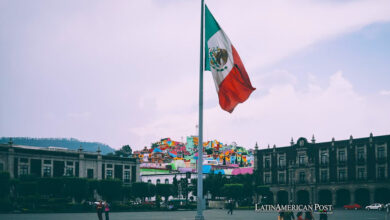Could The Migratory Policies Of Central America and Mexico Reduce The Number Of Illegal Migrants?
Through various migration policies and projects, Mexico leads the plan to reduce illegal migration in one of the most mobile regions in the world .

Photo: PrensaLibre
LatinAmerican Post | Luis Angel Hernández Liborio
Listen to this article
Leer en español: ¿Políticas migratorias de Centroamérica y México para reducir el número de migrantes ilegales?
The reopening of borders, the increase in mobility and the change in US immigration policy have caused the numbers on this topic to return to "normal". According to the Woodrow Wilson International Center for Scholars, almost 50% of the Central American population is in the age range that emigrates the most, that is, 15,431,346 million people. In this context, Mexico is the main route to the "American dream", which is why it has initiated a strategy to reduce Central American migration "attacking the problems that originate it," in the words of the Mexican president.
Biden's support for López Obrador's immigration vision
Although the relationship between Donald Trump and Andrés Manuel López Obrador was good on a personal level, two issues generated friction between the two governments: the North American Free Trade Agreement (NAFTA) and migration. The latter was crucial, since Trump threatened to impose harsh tariffs on Mexican products if the Mexican government did not adjust its actions on immigration to what the US president dictated. In the end, against his migration policy attacking its causes, López Obrador relented: he shielded the southern border with the National Guard and toughened the measures against Central American migration, mainly, which in response organized the so-called "migrant caravans".
With the arrival of Biden to power, US policy coincided with that of Mexico in combating migration through its causes and not only in a punitive manner. According to Human Rights Watch, next May 23 will mark the end of the controversial Title 42, which, using the pandemic as a pretext, allowed the rapid expulsion of asylum seekers to the country of last transit: Mexico. With this pretext, since 2020, 1.7 million people have been expelled, according to data from the United States Customs and Border Protection (CBP) . With this support, at the North American Leaders Summit in November 2021, the US government agreed to co-finance the "Sowing Opportunities" program to combat illegal migration with a humanitarian approach through an investment of 4 billion dollars.
The Mayan Train, the boost to trade with Central America
One of the key works of the Mexican government is the Mayan Train, which is being built in the south of the country, mainly in the Yucatan Peninsula, which includes archaeological sites, tourist areas such as the Riviera Maya and natural paradises such as the jungle. Its intention is to promote economic development in the south of the country. The train will be tourist and cargo, López Obrador has also declared that the Mayan Train should promote the economic development of Central America thanks to the commercial exchange that it can generate, even Guatemala has considered connecting the country with the Mexican train. The start of operations of the Mayan Train is projected for December 2023, so the economic boost it can generate will be in the medium and long term.
"Jóvenes Construyendo el Futuro" and "Sembrando Vida"
Jóvenes Construyendo el Futuro consists of granting monthly scholarships for up to one year to young people between 18 and 29 years old, who must meet a quota of weekly hours as interns in a small, medium or large company, as well as in government agencies. In 2022, young people receive $260 USD per month in Mexico. In Central America, the program began in 2019 in El Salvador and has reached 10,000 people who receive $180 USD per month. Now the program will double the number of beneficiaries, as announced by the Mexican government after López Obrador's recent visit to the region. The program is also present in Honduras and Guatemala, but will now be extended to Belize and shortly to the Caribbean in Cuba and Haiti. The budget for the program does not come entirely from Mexico, it is a co-financing with the Central American countries pending the US contribution that has not been delivered. In Mexico, JCF has had a mixed acceptance, on the one hand it has been recognized as a platform for young people to obtain employment after completing the training, and on the other hand irregularities have been reported.
#VisitaOficialElSalvadorMéxico | El encuentro entre el Presidente @nayibbukele y su homólogo mexicano, @lopezobrador_, ha dejado frutos para El Salvador: los gobernantes anunciaron la ampliación de los programas Sembrando Vida y Jóvenes Construyendo el Futuro. pic.twitter.com/qtUp6rm1Ob
— Secretaría de Prensa de la Presidencia (@SecPrensaSV) May 6, 2022
Sembrando Vida is a program aimed at giving resources to producers to plant timber or fruit trees in order to regenerate the social fabric, boost the economy of the communities, rescue the countryside and protect the environment. In Mexico they receive $250 dollars a month, the program has spread to Guatemala, Honduras, El Salvador and now Belize. A preferential tariff agreement is also included to promote the exchange of products generated in the countries of the region.
El presidente @lopezobrador_ y John Briceño, primer ministro de Belice, firman acuerdo de colaboración para el programa de reforestación Sembrando Vida. Además, se confirmó que se suspenderán los aranceles hacia Belice para abrir un libre comercio con el país. #TribunaSonora pic.twitter.com/VvL2bBjH3r
— Tribuna Sonora (@TribunaSonora) May 7, 2022
You can also read: Donald Trump Reuses His Electoral Formula: Mexico the External Enemy
Border workers
Finally, Mexico seeks to give migrants humane treatment (the same treatment it would like for its own migrants in the United States). Mexico announced that workers from Guatemala and Belize who work in southern Mexico will benefit from obtaining the Unique Population Registry Key (CURP) that will give them identity and access to social and financial services, including access to the Institute Mexicano del Seguro Social, the health institution for Mexican workers. Thus, the Mexican president seeks to expand the social programs that he has in his country towards Central America, something that has earned him severe criticism from the opposition and public opinion because they will be paid for in part with resources from Mexico. It is still early to evaluate the results and verify whether migration has been significantly reduced, as well as whether López Obrador's successor in the presidency in 2024 will continue with the programs.
"IMSS":
Porque López Obrador y su homólogo en Guatemala acordaron que 25 mil guatemaltecos coticen en el IMSS. pic.twitter.com/7husaIs9QO— Por qué es tendencia? (@Sontendenciahoy) May 7, 2022



